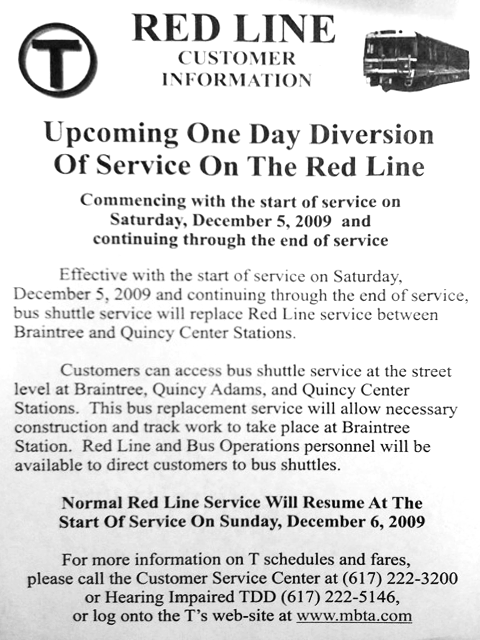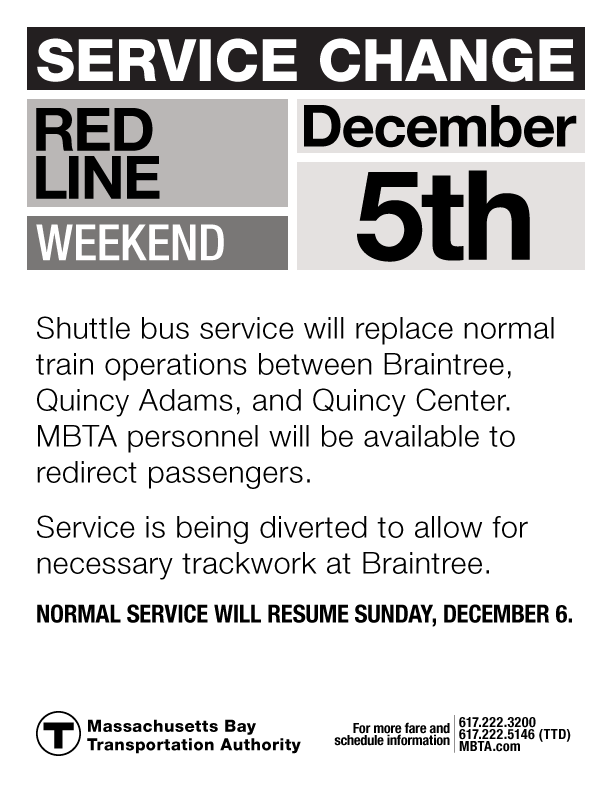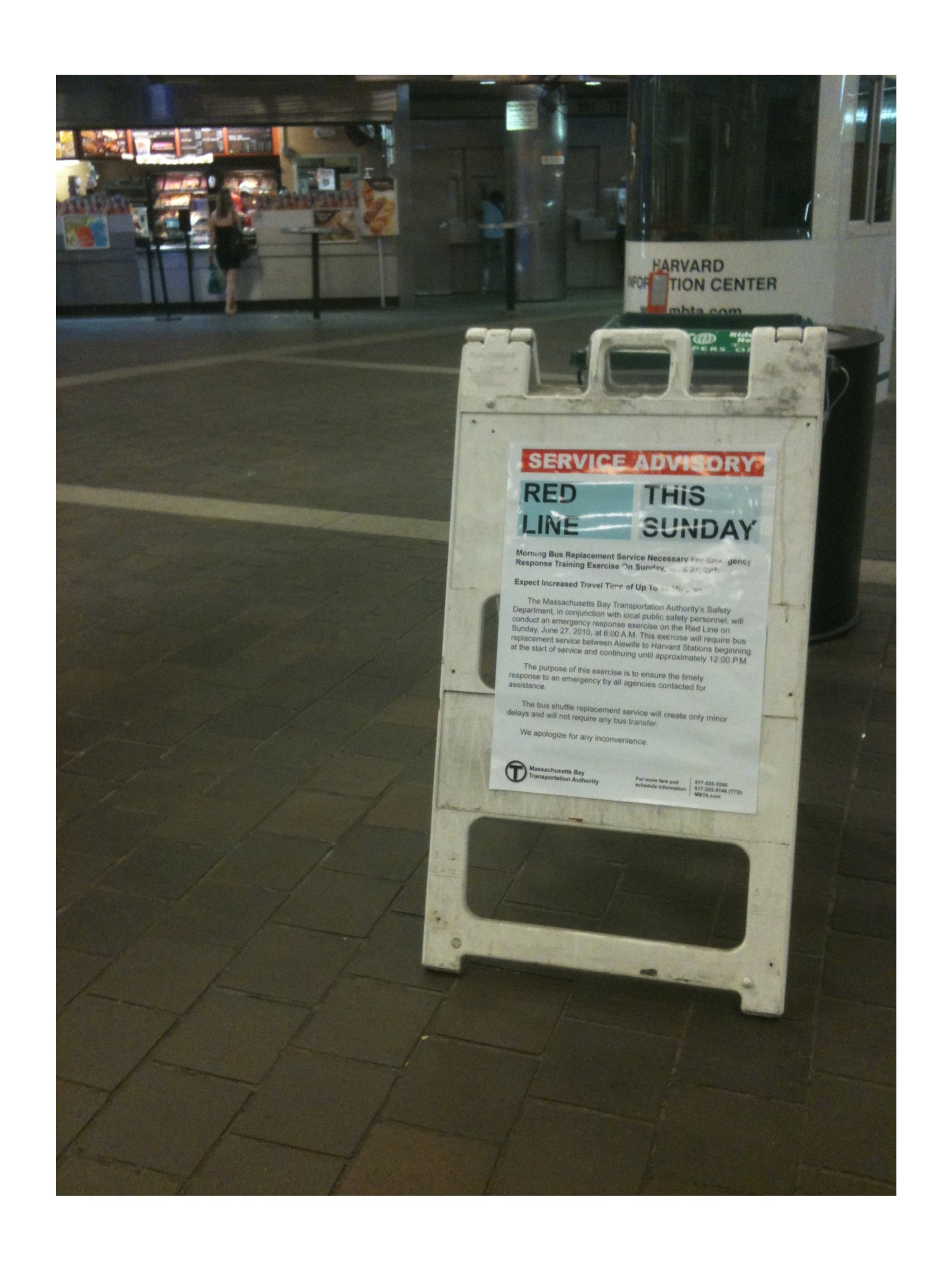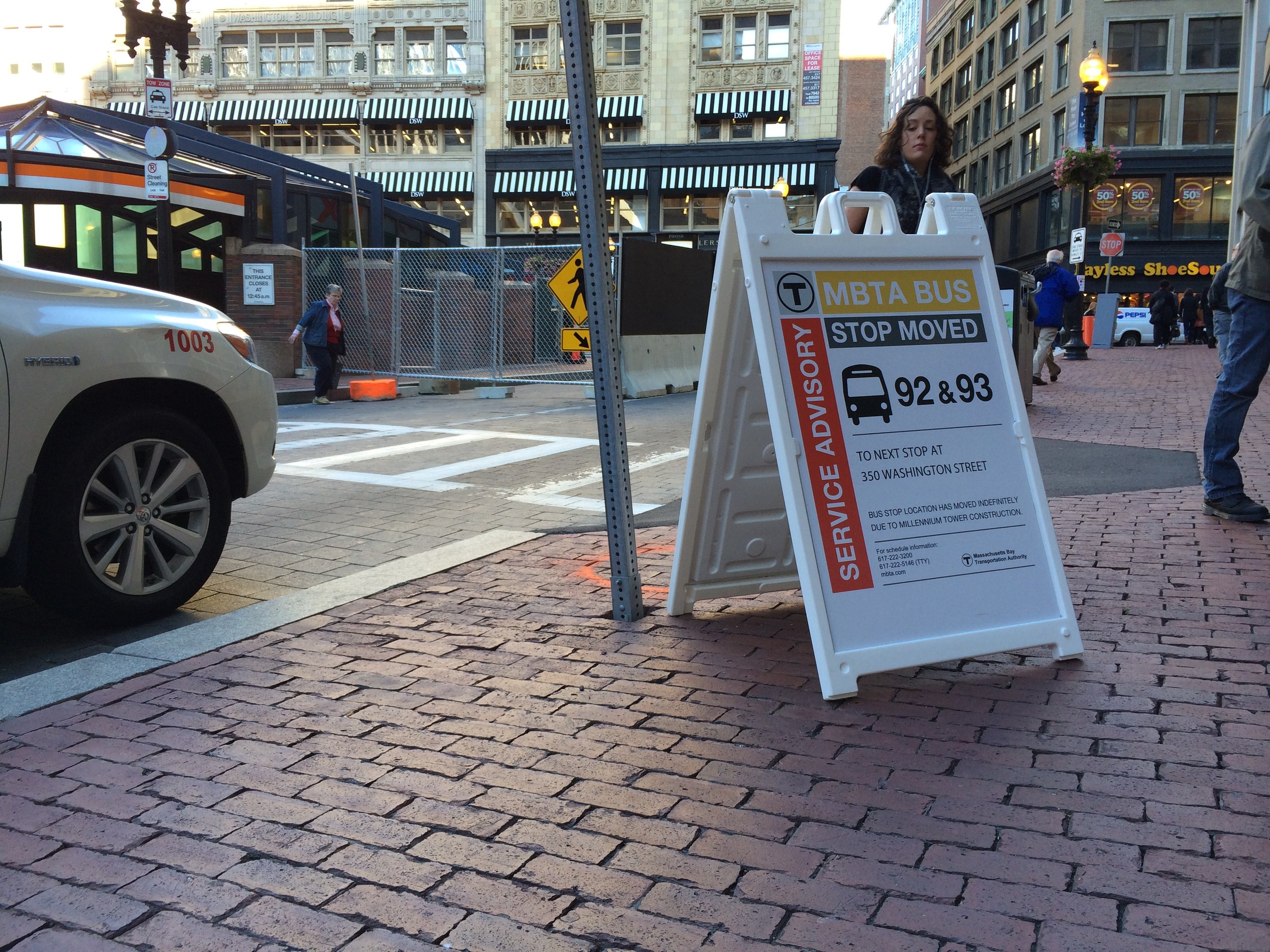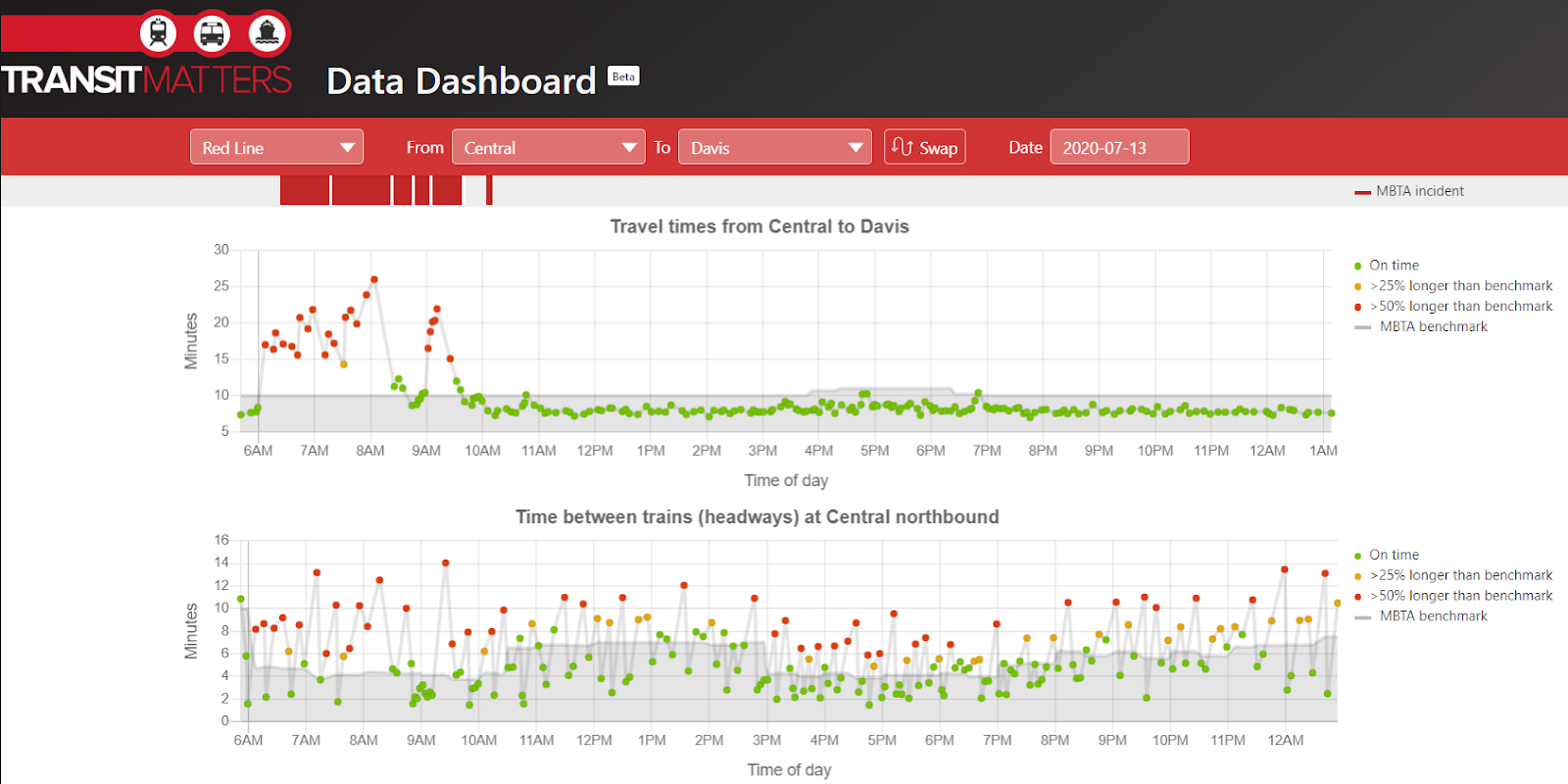
Celebrating 10 Years Of Advocacy: TransitMatters' Guerrilla Poster Campaign
For the next 6 weeks, we will be highlighting landmark moments in our organization’s history so far. First up: Our guerrilla diversion poster campaign, which inspired the T’s current diversion signage.
In December 2009, our founder, Marc Ebuña, came across a Red Line service advisory lying face-down on the floor. This advisory was from a "seat drop," which was one of the ways the T used to communicate with riders about service advisories. Seat drops were not effective. They often ended up on the floor, content side down. Seat drops could not communicate a message to an entire train car, let alone every rider.
The Red Line service advisory Marc found was poorly designed and written more like a press release than an alert. It had too much text, few visual cues highlighting the most important information, and poor branding, making it look unofficial.
We redesigned it, taking a page from the New York City Subway’s advisories at the time. We pulled key information into a high-contrast header, edited down the text significantly, and added the T’s official branding with contact information.
Our redesign posted above a service advisory from the T.
We offered the redesign to the MBTA and received a prompt response from the Deputy Director of Subway Operations. He referred us to the Red Line Chief of Operations, to follow up on design issues. We never got that follow-up.
In March of 2010, the Director of Innovation and Special Projects at MassDOT reached out via the MassDOT Developers Twitter account to invite us to a stakeholder roundtable with the incoming MBTA General Manager, Rich Davey. Here, we mentioned to the incoming General Manager our previous attempts to improve service advisories with staff. He encouraged us to post our designs the next time we saw diversion posters.
Early May 2010, we posted the redesigns. This seemed to push through the internal inertia required to get this prioritized. By mid-June 2010, the T was officially starting to pilot the new signs! Designs continued to evolve internally after then.
Rolling Out Our Data Dashboard
Today, we at TransitMatters Labs are proud to introduce our first tool for independent analysis of MBTA performance, the TransitMatters Data Dashboard.
For the Red, Orange, Blue, and Green lines, we now have trip by trip performance data for the past three months. For any station or station pair, you can see information on how actual MBTA trips performed on that day. We also have real-time updates for the current day!
A key goal we have at TransitMatters is to empower grassroots advocacy for better transit. To achieve this goal over the medium and long term, we perform significant technical work to articulate specific improvements that need to be made for a more reliable, equitable, and capable transit system. Nowhere is this better demonstrated than in our Regional Rail project, especially in our recently released Regional Rail Phase 1 document released earlier this summer.
We also want to be able to influence short term and operational decisions. We want to be able to more effectively keep tabs on the T operational performance and capital delivery projects. While the MBTA has their own site to measure their performance, the information provided is extremely high level and difficult to both understand and audit. Not only that, it rarely reflects the experience of riders who can experience major delays and yet see performance statistics suggesting reliability is >90%. It is powered by significantly more granular data, but most of this data is kept out of easy public view. We have opened up that data to allow for a more nuanced perspective that we believe better reflects the experience of riders on the MBTA.
To that end, over the past few months we at TransitMatters have put together a team of data scientists, software engineers, and UI/UX experts (a/k/a TransitMatters Labs) to give the public better access to MBTA performance data. Our first effort, the New Train Tracker, was released earlier this year and provides real-time information on where new Orange, Green, and Red Line trains are currently running on the system.
Today, we at TransitMatters Labs are proud to introduce our first tool for independent analysis of MBTA performance, the TransitMatters Data Dashboard. For the Red, Orange, Blue, and Green lines, we now have trip by trip performance data for the past three months. For any station or station pair, you can see information on how actual MBTA trips performed on that day. We also have real-time updates for the current day!
For almost every station* on light and heavy rail, you now have the ability to view:
Travel Times: how long it took each train to travel between two stations on the same line, and how long it should have taken according to the MBTA
Headways: how long you have to wait between trains at each station
Dwell Times: how long trains remained stopped at each station
Additionally, for each day we highlight if and when an official MBTA service advisory was issued, and the text of that advisory.
Here’s an example for what the app looks like for July 13th on the Red Line:
The bottom graph displays headways, or time between trains, at Central northbound. Each point (colored in green, orange, or red) represents a number of minutes between each train. The grey line represents the MBTA benchmark, or how long you should have to wait between trains. You can see how it moves up and down through the day, with shorter headways (= more trains) during peak periods, and longer headways (= fewer trains) during off-peak periods.
We color the dots based on the difference from the MBTA benchmark. Green indicates you waited an expected amount of time, yellow means your wait was a little longer than normal (25-50% longer, to be exact), and red means you had a much longer (>50%) than expected wait.
The top graph shows travel times, and behaves similarly to headways. To keep schedules, the T has a benchmark travel time for how long it takes trains to make the journey between two stops (we color this line as grey), which is how they determine the schedules for the trains. This travel time doesn’t change too much through the day, although there is a slight bump during PM peak, where train crowding can lead to longer dwell times at stations.
We mark each dot for the actual travel times, and color these dots based on how close travel times are to the benchmark. Similar to headways, a green dot for travel times means that once you’re on the train, the trip took about as long as you would expect. Yellow means that time on the train was longer than expected, and red means time on the train was much longer than expected. One interesting thing to see here is how for much of the day, actual travel times are far below the benchmark, showing padding the T adds when creating its schedules.
Now, on this day the Red Line had issues early in the morning, with trip times well above expected. We also have the ability to examine what the exact issue was by hovering over the red bar at the top:
You can also see examples where you may have felt there was a delay, but there was no official communication from the T. For example, here’s the Blue Line on a recent weekday. There were significant delays during the PM rush, but no alert from the T to let riders know!
Look out in the future as we roll out more tools to help better analyze the T and its performance. What MBTA data do you want to see visualized? What do you think the Labs team should build next? We’re excited to hear your ideas. If you have any questions, comments, bugs, or suggestions, please contact us at labs@transitmatters.org.
* Due to a change in how the MBTA records performance data, Park St and Kenmore are unavailable currently. We are working on adding them.
Podcast 20 - Advocacy Updates: Fares, Late Night Service, Commuter Rail, GLX and Service Planning to make the MBTA network more effective
This show is focused on MBTA advocacy, with the full crew sharing our thoughts on some of the things in the media lately, and which we've been working on.
Fares increases are proposed again despite the absence of a vision for upgrading and growing our network. It's hard to ask people for more money without real improvements. Some say we should give discounts to low-income riders and raise fares for everyone else. We explore why a two-tier transit system is a terrible idea that will lead to a death spiral and actually impact the poorest riders most. Also, if a transit fare is not a tax, is it a fee?
The MBTA board (FMCB) has proposed eliminating up to 28 bus routes, largely without any analysis of what these routes do or how they operate. A better approach is to figure out why some routes are expensive and/or attract low ridership, such as poor service quality (on-time performance, frequency, connections) and many seem to be designed to fail. The existing late night service is one example, but rather than get rid of it, service should be vastly improved and expanded to full overnight service (don't forget the early morning needs!). Commuter rail come up too.
We talk about the importance of good service planning, the different levels of planning, and how we can not only make small routine changes but also design a better network. Aside from service cuts, no routes have changed since 2008 and a comprehensive review has never been done, even though travel patterns have changed a lot since the 1964 creation of MBTA. Most routes do not meet basic service standards like crowding and on-time performance. How can we plan for upgrades?
The Green Line Extension is way over budget and horribly mismanaged, largely due to schedule pressures, not enough MBTA staff to oversee this massive project (due to austerity) and as a result contractors scamming the T. Are we learning the lessons as the FMCB looks to cut the budget even more? We explain the importance of carrying out the GLX plan which was approved through an extensive public process, and how proposed project reductions would actually cause us to spend more in operating costs to run the line.
This show is focused on MBTA advocacy, with the full crew sharing our thoughts on some of the things in the media lately, and which we've been working on.
Fare increases are proposed again despite the absence of a vision for upgrading and growing our network. It's hard to ask people for more money without real improvements. Some say we should give discounts to low-income riders and raise fares for everyone else. We explore why a two-tier transit system is a terrible idea that will lead to a death spiral and actually impact the poorest riders most. Also, if a transit fare is not a tax, is it a fee?
The MBTA board (FMCB) has proposed eliminating up to 28 bus routes, largely without any analysis of what these routes do or how they operate. A better approach is to figure out why some routes are expensive and/or attract low ridership, such as poor service quality (on-time performance, frequency, connections) and many seem to be designed to fail. The existing late night service is one example, but rather than get rid of it, service should be vastly improved and expanded to full overnight service (don't forget the early morning needs!). Commuter rail come up too.
We talk about the importance of good service planning, the different levels of planning, and how we can not only make small routine changes but also design a better network. Aside from service cuts, no routes have changed since 2008 and a comprehensive review has never been done, even though travel patterns have changed a lot since the 1964 creation of MBTA. Most routes do not meet basic service standards like crowding and on-time performance. How can we plan for upgrades?
The Green Line Extension is way over budget and horribly mismanaged, largely due to schedule pressures, not enough MBTA staff to oversee this massive project (due to austerity) and as a result contractors scamming the T. Are we learning the lessons as the FMCB looks to cut the budget even more? We explain the importance of carrying out the GLX plan which was approved through an extensive public process, and how proposed project reductions would actually cause us to spend more in operating costs to run the line.
The Transit Matters Podcast is your source for transportation news, analysis, interviews with transit advocates and more. By offering new perspectives, uniting transit advocates and promoting a level of critical analysis normally absent from other media, we can achieve a useful and effective transportation network.
Transit Matters. Subscribe to the blog and podcast, join as a member, and sign up to volunteer because we can't do this alone. Follow and engage us on Facebook, Twitter and YouTube, or email feedback@transitmatters.info.
Come to our next Beer & Transit on Thursday Dec 10. We'll have an update and discussion with Transportation for Massachusetts about transit policy issues and their current efforts.
Like this podcast? Share it around, tell your friends and colleagues, and subscribe to the RSS feed to be notified of new posts and episodes.
Categories
- Children (1)
- Diversions (1)
- Olympics (1)
- MAPC (2)
- Red–Blue Connector (2)
- Urban Design (3)
- Bus (4)
- Fares (4)
- Late Night Service (4)
- MBTA ROC (4)
- Silver Line (4)
- Snow (5)
- Blue Line (8)
- Emergency (8)
- Orange Line (8)
- Public Comment (8)
- Maintenance (9)
- Operations (9)
- Signage (9)
- Fare Collection (10)
- Labs (11)
- Safety (11)
- Planning (12)
- Communication (14)
- MBCR (14)
- MassDOT (14)
- Green Line (16)
- History & Culture (16)
- Red Line (18)
- MBTA Bus (21)
- Commuter Rail (24)
- Advocacy (26)
- Capital Construction (28)
- Politics (30)
- Podcast (35)
- News (38)
- Media (40)
- Funding (42)
- Statements (50)
- MBTA (57)


